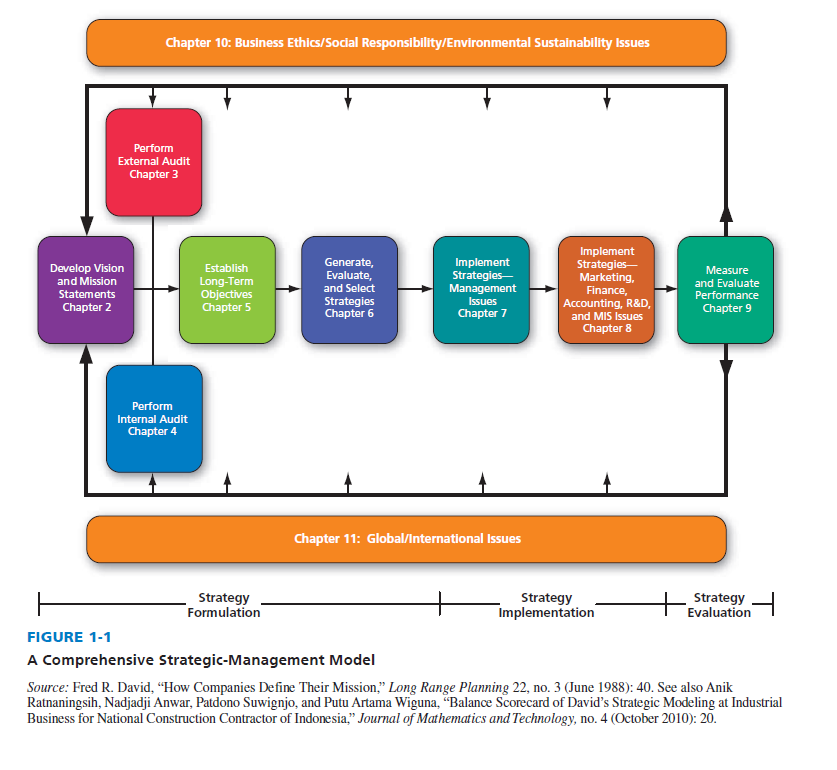The strategic-management process can best be studied and applied using a model. Every model represents some kind of process. the framework illustrated in Figure 1-1 is a widely accepted, comprehensive model of the strategic-management process.14 this model does not guarantee success, but it does represent a clear and practical approach for formulating, implementing, and evaluating strategies. Relationships among major components of the strategic-management process are shown in the model, which appears in all subsequent chapters with appropriate areas shaped to show the particular focus of each chapter. this text is organized around this model because the model reveals how organizations actually do strategic planning. three important questions to answer in developing a strategic plan are as follows:
where are we now?
where do we want to go?
How are we going to get there?

Identifying an organization’s existing vision, mission, objectives, and strategies is the logical starting point for strategic management because a firm’s present situation and condition may preclude certain strategies and may even dictate a particular course of action. Every organization has a vision, mission, objectives, and strategy, even if these elements are not consciously designed, written, or communicated. The answer to where an organization is going can be determined largely by where the organization has been!
The strategic-management process is dynamic and continuous. A change in any one of the major components in the model can necessitate a change in any or all of the other components. For instance, African countries coming online could represent a major opportunity and require a change in long-term objectives and strategies; a failure to accomplish annual objectives might require a change in policy; or a major competitor’s change in strategy might require a change in the firm’s mission. Therefore, strategy formulation, implementation, and evaluation activities should be performed on a continual basis, not just at the end of the year or semiannually. The strategic-management process never really ends.
Note in the strategic-management model that business ethics, social responsibility, and environmental sustainability issues impact all activities in the model, as discussed in Chapter 10. Also, note in the model that global and international issues impact virtually all strategic decisions, as described in detail in chapter 11.
The strategic-management process is not as cleanly divided and neatly performed in practice as the strategic-management model suggests. Strategists do not go through the process in lockstep fashion. Generally, there is give-and-take among hierarchical levels of an organization. Many organizations conduct formal meetings semiannually to discuss and update the firm’s vision, mission, opportunities, threats, strengths, weaknesses, strategies, objectives, policies, and performance. These meetings are commonly held off-premises and are called retreats. The rationale for periodically conducting strategic-management meetings away from the work site is to encourage more creativity and candor from participants. Good communication and feedback are needed throughout the strategic-management process. The Academic Research Capsule 1-2 reveals what activity is most important in the strategic-management process.
Application of the strategic-management process is typically more formal in larger and well- established organizations. Formality refers to the extent that participants, responsibilities, authority, duties, and approach are specified. Smaller businesses tend to be less formal. Firms that compete in complex, rapidly changing environments, such as technology companies, tend to be more formal in strategic planning. Firms that have many divisions, products, markets, and technologies also tend to be more formal in applying strategic-management concepts. Greater formality in applying the strategic-management process is usually positively associated with organizational success.15
What Activity Is Most Important in the Strategic-Management Process?
Recent research has examined the strategic-management process and concluded that perhaps the most important “activity” is the feedback loop, because strategy must be thought of as a “verb rather than a noun.” Rose and Cray contend that strategy is a “living, evolving conceptual entity,” and as such must be engulfed in flexibility. “Flexibility” should also be reflected in the structures put in place to monitor and modify strategic plans. Flexibility safeguards should increasingly be known and practiced throughout the firm, especially at lower levels of the organization. The stages of strategic management (formulation, implementation, and evaluation) are so fluid as to be virtually indistinguishable when one starts and the other ends. Thus, in the comprehensive model illustrated, the encompassing feedback loop is vitally important to enable firms to readily adapt to changing conditions. A significant change in any activity (box) in the model could necessitate change(s) in other activities.
Source: Based on Wade Rose and David Cray “The Role of Context in the Transformation of Planned Strategy into Implemented Strategy,” International Journal of Business Management and Economic Research 4, no. 3 (2013): 721-737.
Source: David Fred, David Forest (2016), Strategic Management: A Competitive Advantage Approach, Concepts and Cases, Pearson (16th Edition).

Hi there, I would like to subscribe for this web site to obtain most recent updates, therefore where can i
do it please help out.